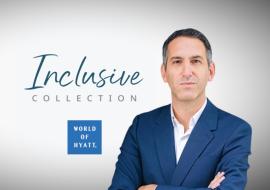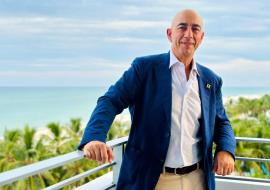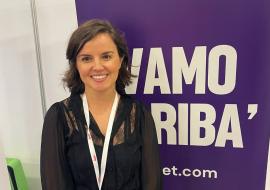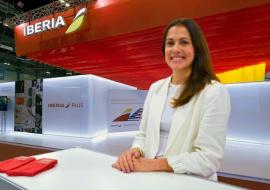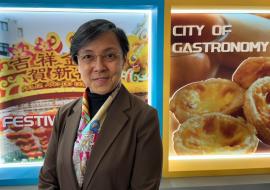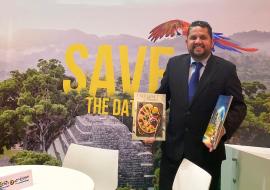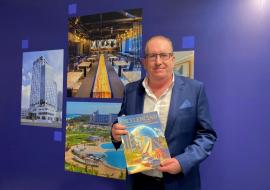Maru Acevedo, Deputy Director of the Guatemalan Tourism Institute
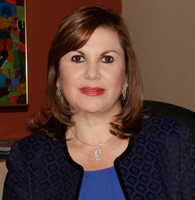
Maru Acevedo is the Deputy Director of the Guatemalan Tourism Institute (INGUAT is the Spanish acronym) and she has a Vice-Minister status at international level. Mrs. Acevedo has occupied several positions within the Guatemalan travel industry over the past 25 years, so she’s one of the people included in the tourism history of that country.
Maru Acevedo has been one of the promoters of the creation of CATA, Central American Tourism Promotion Agency, which helped competing countries of the region become tourism allies and implement tourism projects in the region. Mrs. Maru presently holds different positions; she’s a vice-minister and a member of the new structure of CATA.
What’s your current position in Central America?
We recently assumed the Presidency Pro Tempore of the Central American Tourism Board and CATA’s Executive Council, the two regional authorities that work to strengthen the multi-destination travel industry. It’s a huge commitment and we’re pleased to take it, because we’ve been working for a long time to make the regional integration mechanisms stronger and foster structural changes to boost tourism in our region.
We have spent over ten years joining forces aimed at positioning Central America as a multi-destination in European markets and the experience has been very enriching. We have learned to work in teams and stop seeing us as competition. Quite the reverse, we understand that we’re complementary destinations, with interesting characteristics that make us different from each other and, at the same time, complement the offer since we’re a region that features unique natural and cultural attractions, in a relatively small territory, with great diversity of resources and the hospitality of our people.
This fact has brought about a synergy to work on marketing issues, but, at the same time, we’ve been working at regional level on the tourism offer approach, thus endorsing policies and projects to raise quality levels, speed up processes at the borders, and develop training and supporting programs, as well as a comprehensive tourism assistance and security program.
What’s the difference between a president pro-tempore and an executive director in Central America?
These authorities have different organs. Executive Councils are the highest authorities; in this case it would be the Central American Tourism Board, which is made up of tourism ministers of the region. This board has a technical authority, Executive Committee, and a tourism marketing council, COMECATUR; but the decisions are taken by the Central American Tourism Board. The organized tourism private sector also has a voice in this authority, by means of the Federation of Tourism Chambers of the region and each country’s Tourism Chamber.
The Presidency Pro Tempore changes every six months according to Central America’s Integration System (SICA is the Spanish acronym), so all countries can be at the Presidency with a well-defined strategy and strategic plans at short and long term.
There is an Executive Council in CATA, made up of Tourism Ministers, with full participation of the private sector embodied by Tourism Chambers, and Avianca is a strategic partner. The Presidency also changes every six months. This authority fosters the marketing strategy of multi-destination Central America for its target markets.
Would the Minister of each country be the President pro tempore?
Yes, the presidency pro tempore goes to the Tourism Minister if each country, who can appoint an official to represent him, if necessary.
In the case of Guatemala, who occupies that chair?
The presidency is held by the Director of INGUAT, who has a Minister status at international level and has appointed me to represent him in these regional levels, as well as in Mayan World, which is another regional forum where we promote the multi-destination combined with the Mayan Route.
Furthermore, we are going to hold the Presidency of the Caribbean States Association’s Sustainable Tourism Committee.
We participate in these regional forums because we’re pro-integration as we know that there is strength in numbers, we have great opportunities if we work together and there are many projects to be boosted in an effort to strength the travel industry in our tourism, and there are lessons that are worth sharing.
How long do you have to stay with the executive direction?
The presidency pro tempore rotates every six months and the General Secretariat is permanent.
Are you the present delegate executive director of CATA?
No, we hold the Presidency Pro Tempore and change every six months. There is a Secretary General of CATA, Carolina Briones, and a Secretary General of Central America’s Tourism Integration System, Anasha Campbell. Both authorities are based in Managua, Nicaragua.
What do you make of these ten years of work in CATA to unify opinions and support the weakest countries in terms of tourism promotion?
We’ve seen the promotion of the multi-destination for long-haul markets, such as Europe, and now we have plans to broaden this strategy South America, especially in such countries as Chile, Argentina, Brazil and Colombia, as well as Asian markets in a third stage. The visitors from these regions see us as a region with invaluable cultural and natural offers, shorts distances and complementary attractions, so its’ worth visiting several countries during the same trip.
We additionally promote intraregional tourism, as we are nearly 50 million Central American people that are willing to encourage visits to our region, and we have a lot to offer for local markets.
As for North America, specifically the United States, we label it a short-distance market due to the proximity and airlift, so each country individually develops its marketing strategy.
Over these ten years we have learned that, instead of been competitors, we can complement each other, since the people are looking for unique experiences in the region.
CATA’s new structure doesn’t include the Spain-based office for Europe, how is this promotion going to be carried out?
During the ten years we have spent in Spain with a strategy targeting Europe, we have learned from the model. That’s what we want to apply in other regions in South America and Asia.
Definitively, managing the marketing strategy from Spain with the aim on South America, Asia or Central America, would be operational. The objective of this change is counting on the synergy between CATA and SITCA in Nicaragua and controlling the strategic plans for different regions.
The European market remains a priority and we’re going to intensify our promotion, by means of CATA, the support provided by our embassies and marketing offices, as well as PR agencies that are going to be hired to implement specific plans and projects. With have a special relationship with Spain in terms of history, trade, culture and tourism, so we’ll continue strengthening it and we thank the priceless support we have been given by the government of Spain and AECID for the Central American integration process we’re fostering.







